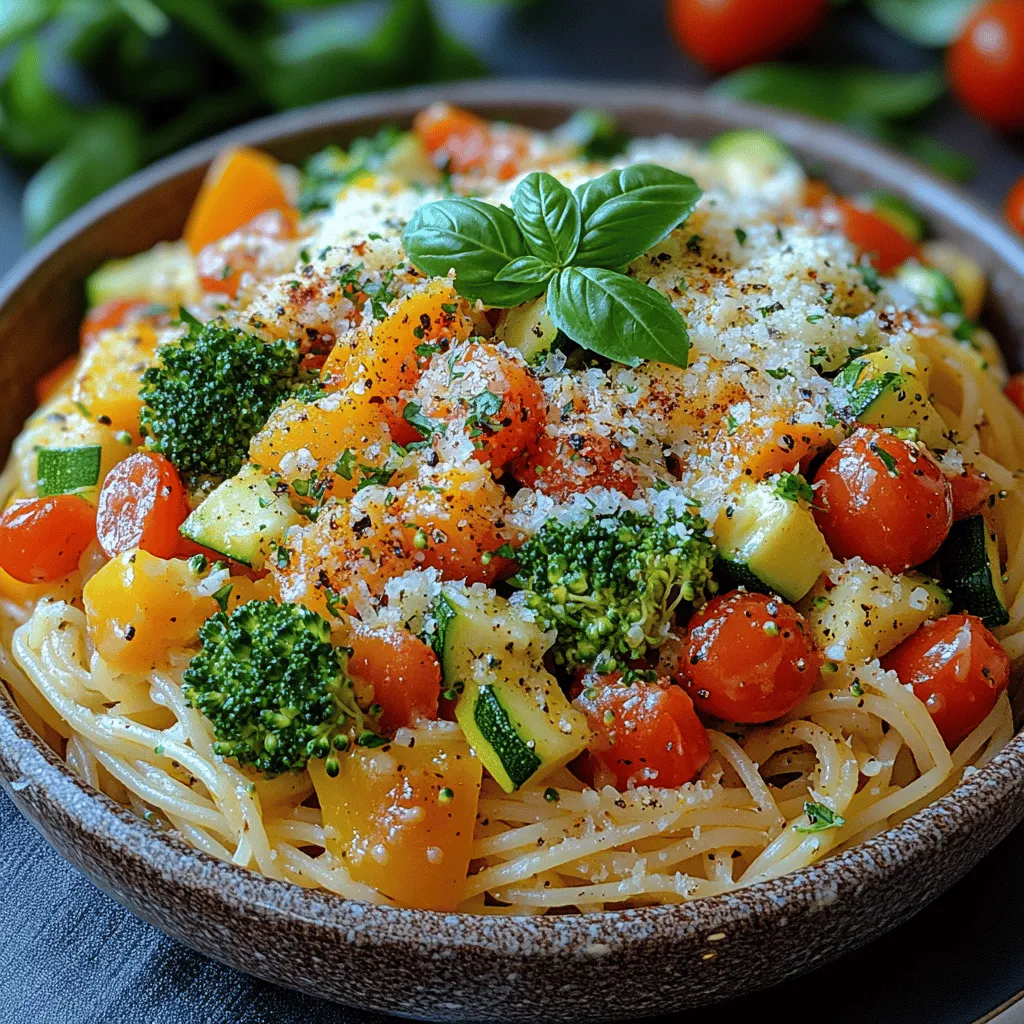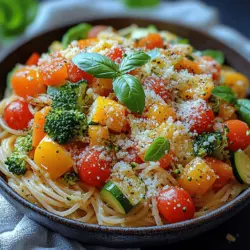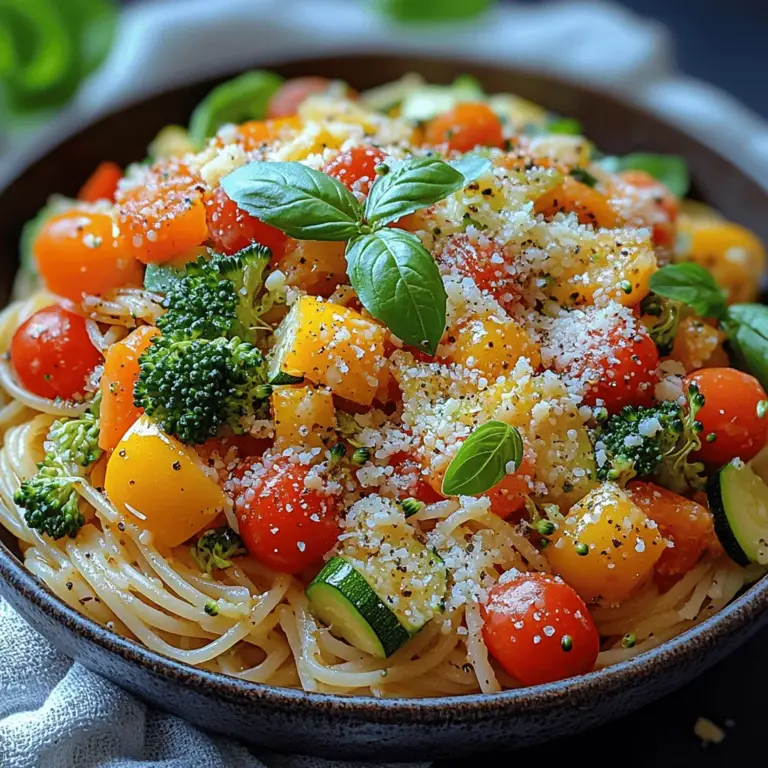Introduction
Pasta Primavera is a classic Italian dish that celebrates the beauty and flavor of fresh vegetables. Originating in the mid-20th century, this delightful meal has become a staple in kitchens around the world, cherished for its vibrant colors and wholesome ingredients. In today’s fast-paced lifestyle, where time is of the essence, the importance of quick and healthy meals cannot be overstated. This is where the idea of the 15-minute preparation time for Pasta Primavera comes into play, making it an ideal choice for busy individuals and families looking to enjoy a nutritious meal without sacrificing quality.
What makes Pasta Primavera particularly appealing is its colorful and nutritious ingredients. Each vegetable brings its own unique flavor, texture, and health benefits to the dish, creating a feast for both the eyes and the palate. In this article, we will explore the origins of Pasta Primavera, delve into the ingredients that make this recipe special, and provide a step-by-step guide to preparing this delightful dish in just 15 minutes.
The Origins of Pasta Primavera
The history of Pasta Primavera is as vibrant as the dish itself. While its exact origins are debated, it is widely believed that Pasta Primavera was created in the United States during the 1970s, inspired by the Italian culinary tradition that emphasizes fresh ingredients and seasonal produce. The word “primavera” translates to “spring” in Italian, reflecting the dish’s celebration of fresh vegetables that are often harvested during the spring season.
Initially, Pasta Primavera was a simple dish featuring pasta tossed with sautéed vegetables, usually served with olive oil and garlic. Its popularity soared in Italian-American restaurants, where chefs began to experiment with various vegetables and sauces, leading to numerous variations across different cultures and regions. Today, Pasta Primavera can be found in various forms, from creamy sauces to light olive oil dressings, appealing to a wide range of tastes and dietary preferences.
The significance of fresh vegetables in Italian cooking cannot be overstated. The Italian culinary philosophy revolves around the concept of “cucina povera,” or “poor kitchen,” which emphasizes using seasonal, locally sourced ingredients to create flavorful and satisfying dishes. Pasta Primavera embodies this philosophy, showcasing the bounty of fresh produce and allowing each ingredient’s natural flavors to shine.
Understanding the Ingredients
To create a truly vibrant Pasta Primavera, it’s essential to understand the role of each ingredient in the dish. Here’s a detailed breakdown of the core components that make this recipe a standout:
Spaghetti vs. Fettuccine: Choosing the Right Pasta for Your Primavera
The choice of pasta can significantly impact the overall experience of Pasta Primavera. Spaghetti is a popular choice due to its long, thin strands that easily capture the sauce and vegetables. However, fettuccine, with its wider, flat noodles, also works beautifully, providing a hearty base that complements the vibrant vegetables. When selecting your pasta, consider your personal preference and the texture you desire in your dish.
Olive Oil: Health Benefits and Its Use in Italian Cooking
Olive oil is a cornerstone of Italian cuisine, known for its rich flavor and health benefits. Packed with monounsaturated fats, olive oil is heart-healthy and contains antioxidants that can help reduce inflammation. In Pasta Primavera, it serves as both a cooking medium and a flavor enhancer, bringing the dish together while elevating the natural flavors of the vegetables.
Zucchini: Nutritional Value and Culinary Uses
Zucchini is a versatile vegetable that adds both texture and nutrition to Pasta Primavera. Low in calories and high in vitamins A and C, zucchini is a great source of dietary fiber, which aids in digestion. When sautéed, zucchini becomes tender while retaining a slight crunch, making it a delightful addition to the dish. Its mild flavor allows it to absorb the surrounding seasonings, enhancing the overall taste of the pasta.
Bell Peppers: Different Types and Their Flavor Profiles
Bell peppers come in a variety of colors, including red, yellow, green, and orange, each offering a unique flavor profile. Red bell peppers are sweet and fruity, while green peppers have a more robust, slightly bitter taste. Yellow and orange peppers are also sweet and add a pop of color to the dish. These vibrant vegetables are rich in vitamins A and C and provide a satisfying crunch, making them a perfect addition to Pasta Primavera.
Cherry Tomatoes: Importance of Using Fresh Produce
Fresh cherry tomatoes are a key ingredient in Pasta Primavera, contributing both sweetness and acidity to balance the flavors. When cooked, they burst and release their juices, creating a light sauce that coats the pasta. Using fresh produce is essential for achieving the best flavor and texture, so opt for ripe, in-season cherry tomatoes whenever possible.
Broccoli: Health Benefits and Preparation Tips
Broccoli is a nutrient powerhouse, packed with vitamins K and C, fiber, and antioxidants. Its slightly bitter flavor pairs well with the sweetness of other vegetables in Pasta Primavera. To prepare broccoli for the dish, cut it into small florets and blanch it briefly in boiling water or steam it until bright green and tender. This quick cooking method helps retain its vibrant color and nutritional value.
Garlic: Flavor Enhancement and Health Benefits
Garlic is a key ingredient in Italian cuisine, known for its aromatic qualities and health benefits. It adds depth and flavor to Pasta Primavera, enhancing the overall taste of the dish. Additionally, garlic is rich in antioxidants and may have various health benefits, including improved heart health and immune function. When sautéing garlic, be careful not to overcook it, as burnt garlic can impart a bitter taste.
Italian Herbs: Discussing the Significance of Dried vs. Fresh Herbs
Herbs play a crucial role in elevating the flavors of Pasta Primavera. Fresh herbs, such as basil and parsley, bring brightness and freshness to the dish, while dried herbs, like oregano and thyme, contribute depth and complexity. When using fresh herbs, add them at the end of cooking to preserve their flavor, while dried herbs can be added earlier in the cooking process to release their essential oils.
Parmesan Cheese: Optional Ingredient and Its Flavor Contribution
While Parmesan cheese is not always included in traditional Pasta Primavera recipes, it can add a delightful creaminess and savory depth to the dish. Grated or shaved Parmesan can be sprinkled on top just before serving, enhancing the overall flavor profile. For a dairy-free option, consider using nutritional yeast, which offers a similar umami flavor.
Fresh Basil: The Finishing Touch and Its Aromatic Qualities
Fresh basil is the final touch that ties the dish together. Its aromatic qualities and sweet, slightly peppery flavor complement the other ingredients beautifully. Adding fresh basil just before serving ensures that its vibrant flavor remains intact, providing a fragrant and flavorful garnish that elevates the dish to new heights.
Step-by-Step Preparation of Vibrant Pasta Primavera
Now that we understand the importance of each ingredient, let’s dive into the step-by-step preparation of Vibrant Pasta Primavera. This quick and easy recipe is perfect for those busy evenings when you want to enjoy a healthy meal without spending hours in the kitchen.
Cooking the Pasta
1. Boil Water: Begin by bringing a large pot of salted water to a rolling boil. This will help enhance the flavor of the pasta as it cooks.
2. Add Pasta: Once the water is boiling, add your choice of spaghetti or fettuccine to the pot. Stir gently to prevent the pasta from sticking together.
3. Cook Al Dente: Follow the package instructions for cooking time, typically around 8-10 minutes, until the pasta is al dente. This means it should be cooked through but still have a slight bite to it.
4. Reserve Pasta Water: Before draining the pasta, reserve about 1 cup of the starchy pasta water. This will be useful later to help create a light sauce that clings to the pasta.
5. Drain and Set Aside: Drain the pasta in a colander and set it aside while you prepare the vegetables.
By following these initial steps, you’re well on your way to creating a delicious and vibrant Pasta Primavera that embodies the essence of fresh Italian cooking. Stay tuned for the next section, where we will explore the cooking process for the vegetables and the final assembly of this delightful dish.

Importance of Salting the Water for Flavor
One of the most critical steps in cooking pasta, especially for a vibrant dish like Pasta Primavera, is salting the water. This step should never be overlooked, as it significantly enhances the flavor of the pasta itself. The general rule of thumb is to use about one tablespoon of salt for every four quarts of water. When the water is salted properly, it will result in pasta that is flavorful and well-seasoned, ultimately elevating the entire dish.
When you add salt to the boiling water, it dissolves and infuses the pasta as it cooks, creating a foundation of flavor that permeates each bite. This is especially important for a dish like Pasta Primavera, where the pasta acts as a canvas for the fresh, colorful vegetables and the light sauce. If the pasta lacks flavor, even the freshest ingredients may fall flat.
Tips for Achieving the Perfect Al Dente Texture
Cooking pasta to achieve the perfect al dente texture is crucial for a satisfying bite. Al dente, which means “to the tooth” in Italian, refers to pasta that is cooked until it is firm to the bite, rather than soft or mushy. Here are some essential tips to help you achieve that ideal texture:
1. Timing is Key: Always refer to the package instructions for cooking time but start checking the pasta a couple of minutes before the suggested time. This way, you can prevent overcooking.
2. Taste Test: The best way to determine if your pasta is al dente is to taste it. Take a piece out of the pot and bite into it. It should be firm yet tender, with a slight resistance.
3. Reserve Some Pasta Water: Before draining your pasta, reserve a cup of the cooking water. This starchy water can be added to your sauce later to adjust the consistency and help the sauce cling to the pasta.
Sautéing the Vegetables
Once the pasta is nearing completion, it’s time to sauté the vegetables. This step is crucial for developing their flavors and ensuring they maintain a vibrant color and slight crunch. Here’s how to effectively sauté your vegetables:
Ideal Cooking Times for Each Vegetable
Different vegetables have varying cooking times, and it’s essential to add them in stages to maintain their unique textures and colors:
– Bell Peppers: Sauté for about 2-3 minutes. They should remain crisp yet tender.
– Zucchini: Cook for around 2 minutes. It cooks quickly and should retain some crunch.
– Cherry Tomatoes: These only need about 1-2 minutes. Cook them just until they start to blister.
– Broccoli: This vegetable can take a bit longer, around 4-5 minutes, to soften slightly while still retaining its bright green color.
Techniques to Enhance the Flavors During Sautéing
– Use High Heat: To achieve a good sear and caramelization, ensure your skillet is hot before adding the vegetables. This will help to lock in their moisture and flavor.
– Add Garlic and Onion: Start by sautéing minced garlic and chopped onion in olive oil. This creates a fragrant base that will enhance the flavor of the vegetables when added.
– Season Gradually: Season the vegetables with salt and pepper as you cook them. This layering of seasoning allows the flavors to develop more fully.
Combining Ingredients
Now that the pasta is cooked al dente and the vegetables are sautéed to perfection, it’s time to combine the two for an even distribution of flavors.
How to Effectively Mix Pasta and Vegetables
After draining the pasta, immediately add it to the skillet with the sautéed vegetables. Use tongs or a large fork to toss everything together gently, ensuring that the pasta is well coated with the vegetables and any residual olive oil. This mixing is vital in creating an integrated dish where every bite is bursting with flavor.
Utilizing Reserved Pasta Water for Optimal Sauce Consistency
If the mixture looks a bit dry, gradually add some reserved pasta water to the skillet. This starchy water will help emulsify the sauce, making it creamy and ensuring it coats the pasta evenly without being overly oily. Start with a few tablespoons and continue to add until you achieve your desired consistency.
Serving Suggestions
Presentation is key when it comes to serving Pasta Primavera. Here are some tips to make your dish visually appealing:
– Plate It Up: Use a large serving bowl or individual plates. Twirl the pasta with a fork for an elegant presentation.
– Garnish: Sprinkle freshly grated Parmesan cheese and torn basil leaves on top for a pop of color and added flavor. You can also drizzle a light olive oil finish for extra richness.
– Add a Splash of Color: Consider adding a few sprigs of fresh herbs or edible flowers to enhance the presentation and make the dish even more inviting.
Nutritional Benefits of Pasta Primavera
Pasta Primavera is not just a delightful dish; it also comes with numerous health benefits, making it an excellent addition to your weekly meal rotation. Here’s an overview of why this dish is a nutritious option:
Overview of the Health Benefits of Incorporating Vegetables
Incorporating a variety of vegetables into your meals provides essential vitamins, minerals, and antioxidants. Vegetables like bell peppers, zucchini, and broccoli are packed with nutrients that support overall health, including:
– Vitamin C: Found in bell peppers and broccoli, it boosts the immune system and promotes skin health.
– Fiber: Vegetables are a great source of dietary fiber, which aids digestion and helps maintain a healthy weight.
– Antioxidants: Colorful vegetables are rich in antioxidants that help combat oxidative stress and inflammation in the body.
Discussion of the Balanced Nutritional Profile of This Dish
Pasta Primavera offers a balanced nutritional profile, combining carbohydrates from the pasta with vitamins and minerals from the vegetables. The dish is low in calories and can be made even healthier by using whole-grain pasta or substituting with a gluten-free option if needed.
Comparisons with Other Pasta Dishes in Terms of Calories and Health Benefits
Compared to traditional pasta dishes that may be laden with heavy creams or sauces, Pasta Primavera is lighter and healthier. For instance, a serving of creamy Alfredo pasta can contain upwards of 700 calories, while a serving of Pasta Primavera typically ranges from 300 to 400 calories, depending on the portion size and ingredients used. This makes Pasta Primavera an excellent choice for those looking to maintain a healthy diet without sacrificing flavor.
Importance of Plant-Based Meals and Their Role in a Healthy Diet
Incorporating more plant-based meals into your diet is essential for overall health. Plant-based diets have been associated with reduced risks of chronic diseases, improved heart health, and better weight management. Pasta Primavera is a fantastic way to enjoy a delicious, plant-rich meal that can be easily customized to suit your taste preferences.
Making Pasta Primavera Your Own
One of the best aspects of Pasta Primavera is its versatility. You can easily tailor the dish to your preferences or dietary needs. Here are some suggestions for customization:
Suggestions for Ingredient Substitutions Based on Seasonal Availability
Take advantage of seasonal vegetables for optimal flavor and freshness. In the spring, consider using asparagus and peas, while in the summer, zucchini, bell peppers, and tomatoes shine. In the fall, you might opt for roasted butternut squash and kale.
Ways to Customize the Dish for Dietary Preferences
For those following a vegan diet, simply omit the Parmesan cheese or substitute it with nutritional yeast for a cheesy flavor without the dairy. Gluten-free pasta can also be used without compromising the dish’s integrity, making it accessible for those with gluten sensitivities.
Incorporating Proteins for Added Nutrition
If you’re looking to boost the protein content of your Pasta Primavera, consider adding grilled chicken, sautéed shrimp, or even tofu for a plant-based option. These additions will not only enhance the dish’s nutritional profile but also make it more filling.
Conclusion
Pasta Primavera is a delightful, quick, and healthy dish that celebrates the beauty of fresh vegetables and the simplicity of pasta. Its vibrant colors and flavors make it an appealing option for any meal of the day, whether served as a light lunch or a satisfying dinner. The recipe’s versatility allows you to experiment with different vegetables, flavors, and proteins, ensuring that you never get bored with your meals.
By preparing this dish at home, you not only enjoy a wholesome meal but also embrace the joy of cooking with fresh, seasonal ingredients. The impact of home-cooked meals on your overall well-being cannot be overstated, as they provide nourishment for both body and soul. So go ahead and try your hand at making Pasta Primavera, and take pleasure in creating a delicious dish that can be personalized to your liking. Happy cooking!


